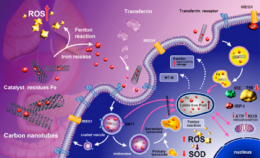カーボンナノチューブ材料の毒性への金属不純物とチューブ構造の寄与
The contributions of metal impurities and tube structure to the toxicity of carbon nanotube materials
2012年12月7日 NPG Asia Materials 4, e12 (2012) doi:10.1038/am.2012.60
ナノ材料:金属不純物が安全性を損なう

カーボンナノチューブ(CNT)は、そのユニークな化学的・電子的特性ゆえに、これまで研究者の関心を大いに刺激してきたが、一方で毒性があるとされているために、研究や応用への使用は疑問視されてきた。このたび、中国科学院(北京)のChunying ChenとYuliang Zhaoをはじめとする研究チームは、CNTの安全性について再調査を行い、ナノチューブ合成に起因する残留金属不純物がCNT毒性に重要な役割を果たすことを示した。研究チームは、これらの金属粒子がナノチューブから容易に溶け出し、肺や胃、腸の体液を模倣した擬似体液に取り込まれることを見いだした。酸性液体に溶け出した鉄粒子は特に、安全上の問題を引き起こす。溶け出した鉄粒子は、ナノチューブ自体をはるかに上回る高いレベルの細胞毒性フリーラジカル種を生成することが、電子スピン共鳴分析によって明らかになったのだ。細胞生存率試験では、ナノチューブサンプル中の金属残留量と培養細胞の生存率の間に、明確な負の相関も確認された。
Nanomaterials: Metal impurities mar safety
Carbon nanotubes (CNTs) are a class of materials that have stimulated a great deal of interest among researchers due to their unique chemical and electronic properties. However, the apparent toxicity of CNTs has raised concerns about their use in research and applications. Chunying Chen and Yuliang Zhao at the Chinese Academy of Sciences in Beijing and their co-workers have re-examined the safety profile of CNTs, highlighting the role that metallic impurities left over from nanotube synthesis play in their toxicity. The researchers found that these metallic particles readily leach out of the nanotubes, including into simulated biological fluids mimicking those found in the lung, stomach and intestines. Iron particles leached into acidic fluids caused particular safety concerns—electron-spin resonance analysis showed that leached iron particles were generating cytotoxic free radical species at levels much higher than the nanotubes themselves. Cell viability studies demonstrated a clear negative correlation between the amount of metal residue in the nanotube sample and the health of the cultured cells.

